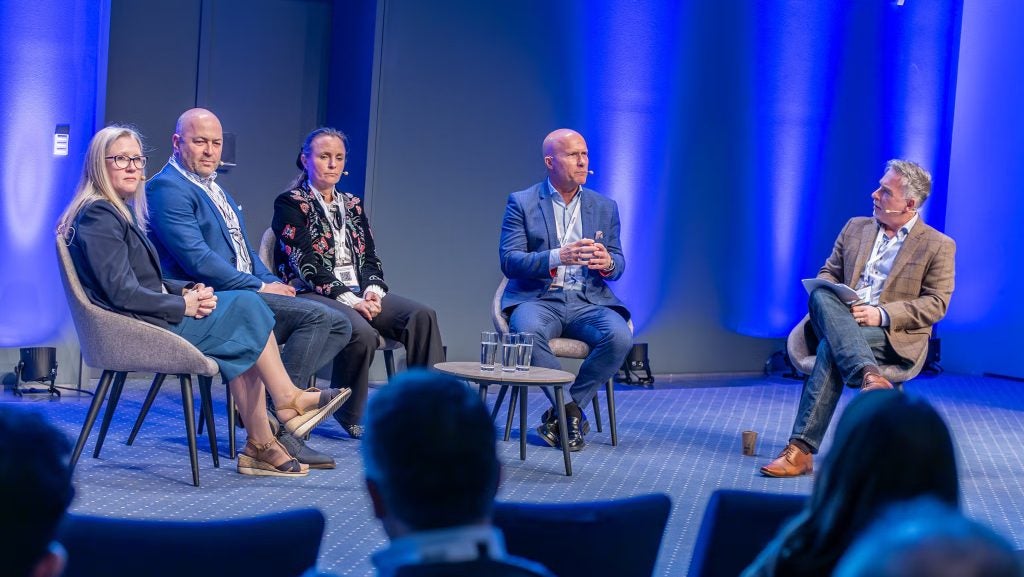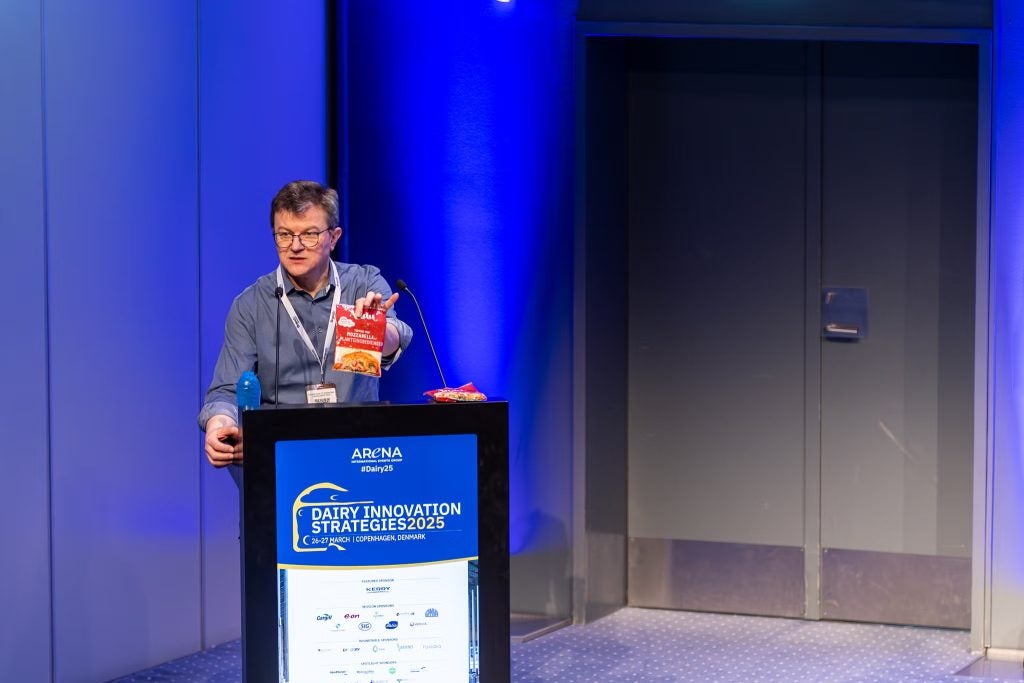
Opportunity was the theme that buzzed around the Dairy Innovation Strategies conference in Copenhagen – the industry just has to find new ways to grasp it.
Consumers are becoming increasingly savvy about what’s good for them and what isn’t and are making purchasing decisions accordingly, which makes transparency by dairy manufacturers, and the wider food fraternity, ever more crucial. It’s become a much more consumer than producer-driven environment.
“We are in an era of heightened environmental awareness but also evolving consumer preferences and expectations,” was how Sibéal Bird, the European sustainability director at Kerry Group, framed it as she kicked off the two-day event sponsored by Just Food’s sister company Arena International.
“We know that the majority of European consumers are increasingly prioritising sustainability and very much so the health of our planet, and the shift in demand for more sustainable products is putting pressure onto everyone within the supply chain.”
Sustainability was only one of a plethora of topics up for discussion, with conference participants no doubt eager to hear, and share, the views of their European dairy counterparts and the industry faces turbulence in volumes.
Growing health and nutrition considerations among consumers, demand for quality at an affordable price, the need for innovation, particularly around functionality, and plant-based vis-à-vis hybrid products were all on the menu.

US Tariffs are shifting - will you react or anticipate?
Don’t let policy changes catch you off guard. Stay proactive with real-time data and expert analysis.
By GlobalDataHowever, a particularly interesting aspect was thrown into the arena by Jemma Luxford, the commercial director for Suckies dairy pouches brand maker The Collective – convenience, but more crucially, convenience around snacking.
“As an industry, we’re not quite doing a good enough job to create the solutions that truly overcome the barriers that consumers have about how you bring that healthy, nutritious snack on the go,” Luxford argued.
“Consumers are craving convenience more than ever. We as an industry need to adapt and evolve to create solutions that are quick, convenient and snackable that can enable us to grow and develop alongside this category.”
Luxford spoke to that opportunity, especially toward the Gen Zs who are turning away from the typical three-meals-a-day, around creativity.
“Dairy has a competitive advantage because it is so nutritionally dense that it’s the perfect snack. Ultimately for our industry, the penetration is really high, it’s pretty much maxed out, and value is really low.
“It’s hard for us to find opportunities to grow, and we need to be able to find new occasions for consumers to drive that growth.”
‘Credible messaging’
One of those opportunities is meeting consumer needs around heightened awareness in terms of a healthy diet, namely reducing fat, sugar and salt in dairy and innovating for the immediate and longer term but also with a slant toward sustainability.
“Nutrition has never been more topical,” Kerry’s Bird said, emphasising how people are searching out products that are natural and clean label, while retailers are also becoming more transparent.
“As a result, we’re seeing that retailers are actually making their sugar reduction and nutrition optimisation claims public and available to consumers, which in turn, is putting huge pressure back onto brands and producers,” she argued.
“Sustainability claims have become incredibly crucial for brands but the authenticity behind those claims is receiving heightened scrutiny. Consumers are looking for clear, concise and credible messaging and data behind that.”
Protein at a price
In a round table discussion, Vicky Davies of the ingredients division of dairy giant FrieslandCampina, suggested the opportunities for innovation are “huge” but with the need to continue to adapt to changing consumer dynamics, including around people considering “longevity” as well as sustainability in their purchasing decisions.
“I think we have not only an opportunity but a responsibility to be able to innovate and deliver on the health needs that they have,” the FrieslandCampina global marketing director for performance, and active and medical nutrition, said.
“Innovation is always going to be tough. Consumers want something new all the time.”
Differentiation is also a challenge but more so around backing product and health claims with solid evidence, an area where regulators can play a part in ensuring quality control, Davies suggested, referring to what she calls “sweeping statements”.
It was a similar view shared by Mike Bagshaw, the owner of UK-based International Taste Solutions (ITS), which caters to the dairy industry and other food sectors.
“If I was being brutally honest, most of the protein sales are protein at a price,” Bagshaw said in the round robin discussion.
“We’re seeing huge growth in 25 grams of protein for under a euro. I’m not sure people are looking at the credentials when they buy that product.”
There’s a need for better education and awareness among consumers too with evidence-based facts to ensure people aren’t being hoodwinked or the risk consumers take on-pack product claims at face value, he suggested.
“I’m not entirely convinced about claims on packs because I think sometimes they often seem too good to be true,” Bagshaw said.
He used a similar analogy for the plant-based dairy market, which like other alternative food categories like meat-free haven’t always delivered on promises, especially around quality and taste, and even price.
“I’m personally not entirely convinced with it. I think what will happen is you’ll get a few very good, strong brands with really good technology, really clean label. They’re the ones that I think will make it, and I think they’ll be a bit more of a day of reckoning for some of the others. And it’s already happening,” he argued.
From FrieslandCampina’s perspective, Davies said the Dutch company did launch some plant-based dairy options on the consumer and ingredients side, mostly through partnerships, but the decision was more to do with giving people more choice.
“Our core is in dairy, and we have gone back to that and also strengthened that, and we’ll continue to do so,” she says.

Hybrid dairy
Hybrid dairy products might arguably be the solution to cutting emissions from agriculture, particularly so for the dairy industry. One such company is PlanetDairy in Denmark, which is producing cheeses combining real dairy with plant-based ingredients.
Kerry Group took a similar path last year, launching the Smug hybrid range of products, including cheese, butter and a milk drink.
Paul Cornillon, the head of R&D and one of the founders of PlanetDairy, said the company is on a “mission to help consumers and customers shift or transition to new dairy with low CO2s”.
The key challenge with full-blown dairy alternatives is taste, closely followed by price, he contends.
“A solution for the dairy industry is to swap completely to plant-based but it’s not that easy. If your product doesn’t taste [good], you’re doomed. It’s not going to work,” Cornillon says.
“If we are to help consumers and customers to shift to new dairy with less CO2, that new dairy, whatever it is, has to taste like dairy, it has to be functional like dairy, it has to be nutritious like dairy.”

Milk alternatives
From an alternative milk perspective, Ilse Siekkinen, the general manager for the Nordics region for US-based Oatly, said there is room to “explore hybrids” in the dairy drinks space as the market is not so “polarised” as it once was, where consumers either picked a plant-based beverage or real milk, with no compromise.
However, she stressed Oatly continues to “believe in the power of oats” because of their nutritional value and sustainability credentials.
Habits are also changing among different generations in the types of coffee consumed, when they drink the beverage and the choice of milks, which presents opportunities for plant-based varieties, Siekkinen said.
She noted an increase in so-called “cross shopping”, where households are purchasing both dairy-based milks and plant-based versions to fit different occasions and individual applications.
“I’d say there’s a shift a bit in consumer behaviour within different generations. I could almost say that there’s a bit of a paradigm shift when it comes to coffee consumption. We see that, for example, the younger generations are starting to consume coffee differently – it’s more cold coffees and other different coffee drinks,” she suggested.
“Younger generations consuming less alcohol, I think can also open up a new era for drinks when it comes to plant-based drinks, and we can drive that movement forward and indulge in some taste experiences in different occasions.”
As well as educating consumers on the benefits of consuming alternative milk drinks it’s also about transparency and providing accurate information, while there’s plenty of room for further innovation with a focus on high quality and taste, Siekkinen said.
Quality issues
Joining the discussion on milk alternatives was Christian Christensen, the CEO of Denmark-based Dryk, which produces a range of beverages using oats or peas as the main protein ingredient, with an emphasis on sustainability and CO2 reduction.
He took up the quality mantle put forward by Siekkinen, arguing that, as with other dairy alternatives, there remain issues with some products on the market, particularly around taste, presenting the risk that people don’t come back with repeat purchases.
“The biggest threat to us is really cheap products of questionable quality. Taste is becoming the most important part in our industry and it’s clear that the market is shifting towards higher quality, which is seen in the supermarket, in cafes and restaurants,” he contended.
“We’re in a market where there’s a really high will from the consumers to pay, and we see products that are of questionable quality sold for very high prices. That’s really a struggle that we have to sort out over time.”
There needs to be universal regulation across the EU rather than specific legislation for individual markets, especially when it comes to fortifying alternative-dairy beverages with things like vitamins and minerals, he said.
Sustainability remained an overarching point of discussion during the Arena event. And dairy manufacturers must take up the baton with solutions geared toward diffusing bad press for the industry around emissions, Kerry’s Bird stressed.
Solutions also need to be long term, with innovation presenting one of the greatest opportunities.
“No one strategy here in isolation is going to be working. It’s about looking at on-farm intervention and what can be done to actually reduce the carbon footprint of the milk,” she suggested.
“It’s about reducing the volume of dairy in a product and maybe creating hybrid products, looking at technologies to be able to reformulate, to create the same user experience and consumer preference in a way that is enhancing both nutritional optimisation and lowering the carbon footprint.”
Bird added: “I’m not talking about tomorrow, I’m talking about five, ten, 15 years. How are we making sure that we’re getting the most out of the dairy ingredients that we are using?”



